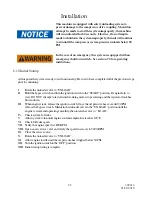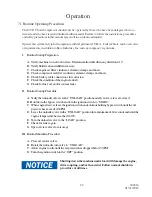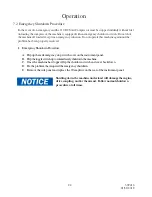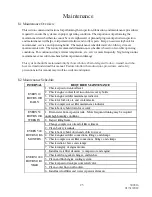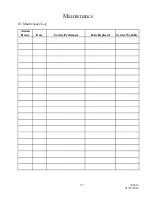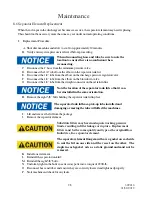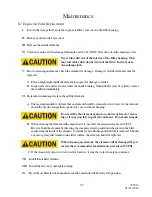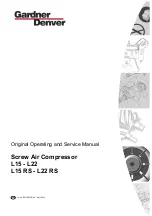
15
309416
01/31/2012
Description of Components
The 210 DUS Air Compressor contains a John Deere, 4 cylinder diesel engine. This engine has been
selected to handle the rugged duty required for its operation. The engine speed is regulated by a
pneumatic throttle control.
5.1Engine
5.2Drive Coupling
Power from the engine is transmitted to the compressor input shaft through a specially designed drive
coupling. The drive coupling consists of a highly torsionally flexible rubber disc that mates with an
engine flywheel flange. The coupling provides a torque limitation to protect from system overloads.
5.3 Compressor Airend
The Boss Industries, Inc. compressor airend is a positive displacement, oil flooded, rotary screw type
unit employing one stage of compression to achieve the desired pressure. Components include a
housing (stator), two screws (rotors), bearings, and bearing supports. Power from the engine flywheel
is transferred through a gear set to the male rotor. The female rotor is driven by the male rotor. There
are five lobes on the male rotor while the female rotor has six roots.
In operation, two helical grooved
rotors mesh to compress air. Inlet air is trapped as the male lobes roll down the female grooves,
pushing trapped air along, compressing it until it reaches the discharge port at the end of the stator which
delivers smooth-flowing, pulse-free air. Being an oil flooded system, the oil serves three purposes:
lubricates the rotating parts and bearings, serves as a cooling agent for the compressed air, and seals the
running clearances.
5.4 Separator System
I.
Separator Tank
From the compressor airend, the compressed air and hot oil flow into a steel, ASME coded,
pressure vessel, rated at 250 PSI, that acts as an oil reservoir. This tank is the first of two stages in
separating the oil and compressed air mixture. From the bottom of the separator tank, oil is forced
to the oil filter.
II. Separator Element
At the top of the separator tank is the separator element. The separator element removes the oil
mist from the air as it is passed on to the minimum pressure valve. As the air/oil mist passes through
the outside of the media, oil gathers on the interior walls and settles to the bottom of the element.
Collected oil is returned to the compressor airend through the oil return line. The separator will filter
the oil concentration in the air to less than 3 parts per million.






















